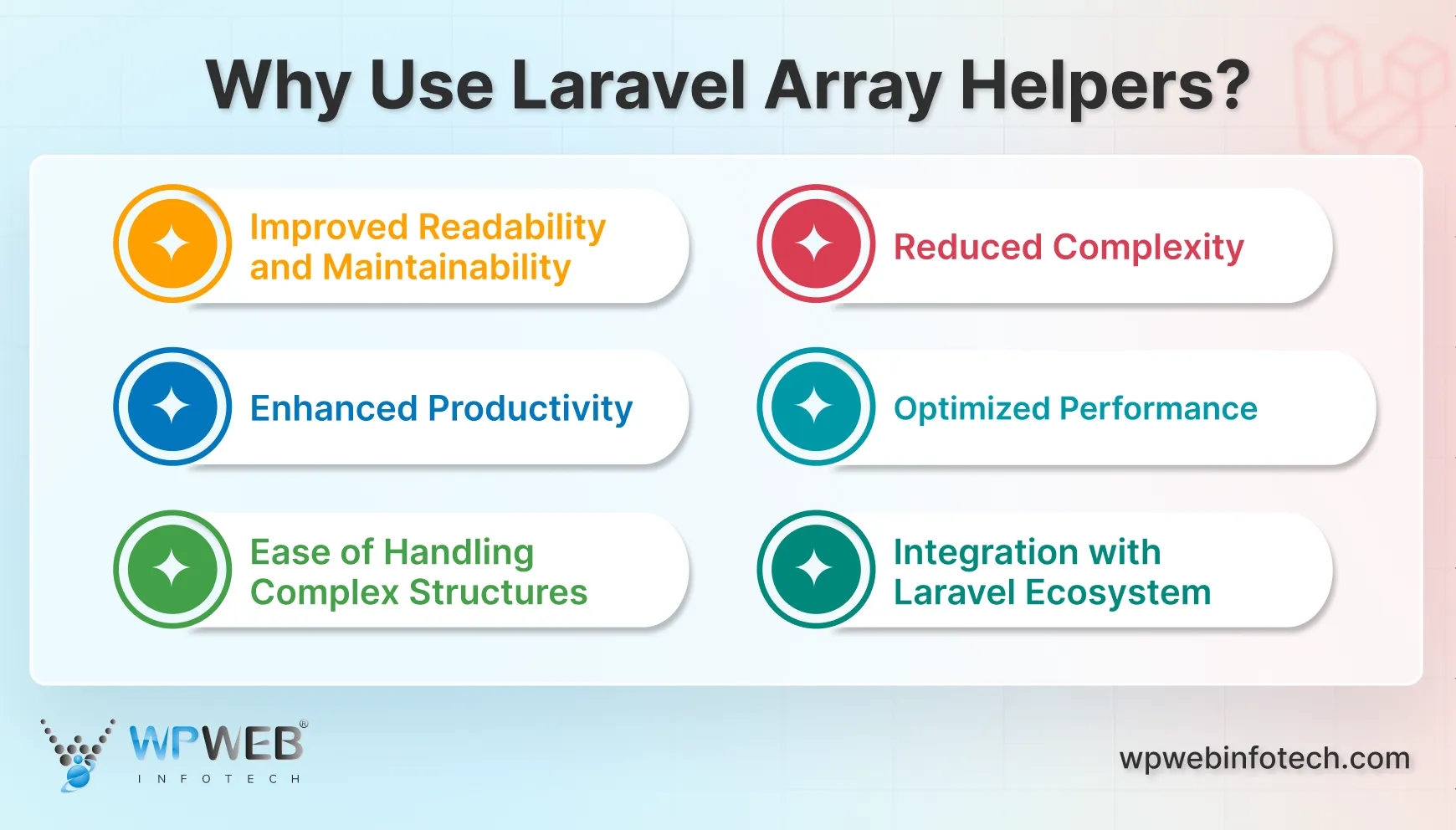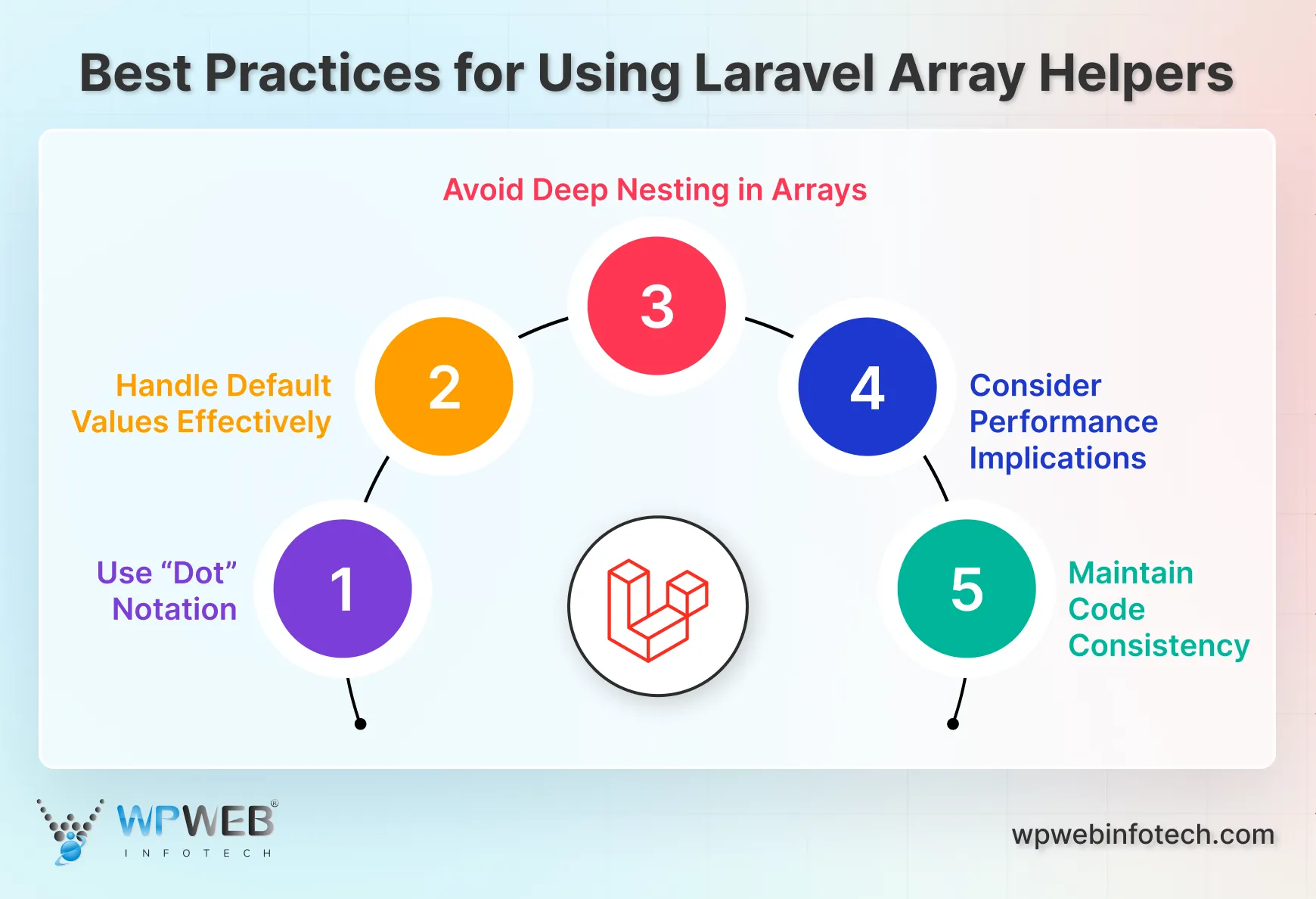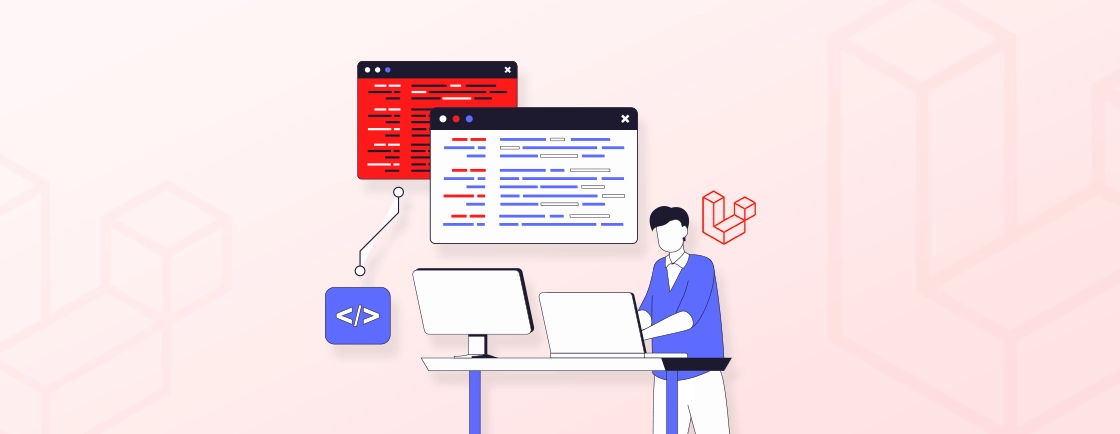Quick Summary
Mastering Laravel array helpers can transform the way you handle data in your web applications. These built-in utility functions simplify common array operations like adding, sorting, filtering, and retrieving values – helping developers write cleaner, more efficient, and maintainable code. This blog dives deep into the power of Laravel’s Arr facade and essential best practices to enhance performance and productivity in Laravel development.
Table of Contents
One of the key tasks in web development with Laravel is creating a clean, efficient, and maintainable codebase. Data, often stored in arrays, is the lifeblood of your web app. Laravel array helpers provide a robust toolkit to manipulate and navigate these arrays with ease.
These Laravel array functions not only save you time and effort but also promote a more readable and maintainable codebase. Integrating array helpers in Laravel is a breeze – they’re readily available throughout your Laravel project, accessible through the Arr facade. Laravel experts use them for everything from extracting specific values to sorting and restructuring your data.
In this blog, you will learn about the Laravel array helpers and how they are used in the development process.
What are Array Helpers?
Array helpers in Laravel are a set of utility functions designed to perform common operations on arrays. These Laravel array methods simplify manipulation tasks, making your code cleaner and more readable. With these Laravel helpers, developers can efficiently add, remove, search, or sort array elements without writing complex logic.
For instance, using array_get($array, ‘key’), you can retrieve a value from a nested array with a default fallback. For example, array_get([‘user’ => [‘name’ => ‘John’]], ‘user.name’, ‘Default’) returns ‘John‘, simplifying array access.
Why Use Laravel Array Helpers?
Laravel array helpers make array manipulation more efficient and effective. Array helpers not only enhance efficiency but also contribute to cleaner and more readable code. Here are the advantages it offers:

Improved Readability and Maintainability
Array helpers enable you to achieve complex operations in fewer lines of code than manual loops or chained PHP array functions. This results in cleaner, more concise code that’s easier to maintain and modify in the future. Similarly, using accessors and mutators in Laravel ensures cleaner, standardized data handling when retrieving or saving model attributes.
Reduced Complexity
Working with arrays can involve repetitive tasks, when dealing with nested structures or conditional checks. Laravel array helpers simplify these tasks by providing pre-built functions for common operations. It reduces the complexity of your codebase.
Enhanced Productivity
Leveraging array helpers can significantly improve your development speed. The concise syntax and built-in functionalities save you more time than writing manual loops. This allows you to iterate faster and focus on delivering features more efficiently.
Optimized Performance
Laravel array helpers are optimized for performance, ensuring efficient execution of array operations. They are extensively tested to ensure your code remains performant, even when dealing with large datasets.
Ease of Handling Complex Structures
Laravel offers specific helper functions for manipulating multi-dimensional arrays and dot notation structures. Functions like Arr::collapse and Arr::dot simplify the use of nested arrays. This makes it easier to handle complex data structures.
Integration with Laravel Ecosystem
Laravel array helpers are designed to work seamlessly with other components of the Laravel framework. To better understand how Laravel simplifies access to these components, facades in Laravel streamline interaction with the framework’s core services.
These advantages offered by Laravel array helpers ease the tasks of filtering arrays, merging arrays, and other array operations. By utilizing array helpers, experts can build your site more effectively and efficiently.
How to Use Laravel Array Helpers?
Laravel array helpers are built-in functions that simplify array manipulation, resulting in cleaner and more efficient code. To achieve a higher level of customization and flexibility, developers often create custom helper functions in Laravel to build tailored solutions. Here’s how they can be implemented with practical examples:
Step 1: Accessing the Helpers
Laravel array helpers are built-in functions. You can access them directly in your code without the need for any additional imports.
Step 2: Choosing the Right Helper
There are numerous array helpers available in Laravel, each designed for a specific task. The official Laravel helpers documentation provides a comprehensive list and explanation of each helper function. Here are some guidelines to help you select the appropriate helper:
- If you need to add a new value to an array with a specific key, use array_add.
- If you need to sort an array using a given callback, use array_sort.
- If you need to check if a key exists in an array, use array_has.
- If you need to retrieve a value from a nested array using “dot” notation, use array_get.
These are just a few examples, you can explore more options as per your needs.
Step 3: Using the Helper Function
Once you have chosen the helper function, you must follow a structured syntax to use it. The structure is like:
$result = Arr::functionName($array, $arguments);
Here is what each argument in this code suggests to the compiler:
- Arr: This is the facade that grants access to the helper functions.
- functionName: This represents the specific helper function you want to utilize (e.g., get, first, map).
- $array: This is the array you intend to operate on.
- $arguments: Certain helpers might require additional arguments depending on their functionality (e.g., a default value for Arr::get, a callback function for Arr::map).
By understanding this structure, you can effectively use various array helpers for array operations.
Practical Examples
Now you know how to structure your code for using the array function, let’s see some examples for better clarity:
- To retrieve an element
$name = Arr::get($users, 'john.name'); // Returns the value associated with the 'name' key for user 'john'
- To filter an array based on a condition
$activeUsers = Arr::where($users, function ($user) {
return $user['active'] === true;
});
- To transform an array using a callback
$usernames = Arr::map($users, function ($user) {
return $user['name'];
});
These are some of the basic but practical uses of array helpers. You can explore more functions and combinations of its case for various tasks.
By following the above process, you can learn to use array helpers for various array operations. But if you need to create more complex functions, consider hiring a Laravel development agency. They can handle a large array of datasets and transform them to meet your needs.
List of Laravel Array Helpers
Laravel provides a comprehensive set of array helper functions that are accessible through the Arr facade. Here’s a breakdown of some commonly used Laravel array helpers categorized by their functionality:
Accessing Elements
These helpers are used to access elements within an array, including nested arrays, using methods such as dot notation or array keys.
- Arr::get($array, $key, $default = null): Retrieves a specific element from an array by key. If the key doesn’t exist, it returns the provided default value (defaults to null).
- Arr::first($array, $callback = null, $default = null): Returns the first element of the array. Optionally, you can provide a callback function to filter the elements or a default value if the array is empty.
- Arr::last($array, $callback = null, $default = null): Returns the last element of the array. Like Arr::first, you can use a callback for filtering and a default value for empty arrays.
- Arr::pluck($array, $key, $default = null): Extracts a specific key or value from each item in an array and returns a new array containing the extracted elements.
Choose if: You need to access specific elements in an array. This is especially useful for handling missing or default values and nested arrays.
Modifying Arrays
These helpers are used to modify arrays by adding, updating, or removing elements.
- Arr::add($array, …$items): Adds one or more elements to the end of the array.
- Arr::prepend($array, …$items): Adds one or more elements to the beginning of the array.
- Arr::forget($array, $key): Removes a specific element from the array by key.
- Arr::only($array, $keys): Returns a new array containing only the specified keys.
- Arr::except($array, $keys): Returns a new array with all keys except the specified ones.
Choose if: You need to modify arrays by adding, updating, or removing elements in a concise and readable manner.
Checking Array Content
These helpers are used to check the content of arrays, including checking for the existence of keys or values.
- Arr::has($array, $key): Checks if a specific key exists in the array.
- Arr::hasAny($array, $keys): Checks if any specified keys exist in the array.
- Arr::isAssoc($array): Determines if the array is associative (key-value pairs).
- Arr::isList($array): Determines if the array is a simple list of values (numeric keys).
Choose if: You need to check the content of arrays, such as checking for the existence of specific keys or values.
Transforming Arrays
These helpers are used to transform arrays into different structures or formats.
- Arr::map($array, $callback): Applies a callback function to all elements in the array and returns a new array containing the results.
- Arr::filter($array, $callback = null): Filters the array elements based on a callback function and returns a new array containing only the elements.
- Arr::sort($array, $callback = null): Sorts the array elements. You can optionally provide a callback function to define the sorting criteria.
- Arr::shuffle($array): Randomly shuffles the order of the array elements.
Choose if: You want to transform an existing array to a new structure as per your need.
These lists have some number of the total array helpers available. These functions will help you get more understanding of how they can be useful for array operations.
Best Practices for Using Laravel Array Helpers
Using Laravel array helpers effectively ensures your code remains readable, maintainable, and efficient. These best practices will help you maximize the benefits of Laravel’s powerful array utilities and maintain a professional codebase.

- Use “Dot” Notation: Laravel provides array helper Laravel functions like Arr::dot and Arr::undot to convert between multi-dimensional arrays and dot notation. Use “dot” notation for moderate nesting; for deeper structures, consider loops or recursion for better clarity.
- Handle Default Values Effectively: Leverage default values to avoid unnecessary conditionals. Functions like Arr::get let you specify defaults if a key doesn’t exist, improving reliability and reducing potential errors.
- Avoid Deep Nesting in Arrays: While Laravel array functions can manage complex data, overly nested arrays reduce readability. Use helpers like Arr::collapse to simplify structures or refactor your data for better performance.
- Consider Performance Implications: With very large datasets, assess whether array helpers or manual loops perform better. Choose the method that balances clarity and speed based on your project’s needs.
- Maintain Code Consistency: Follow Laravel’s naming conventions and use array helpers consistently. Combine them with string helpers for a unified approach to data manipulation and easier team collaboration.
To get the most from these practices, consider consulting professionals who can help optimize your Laravel site. Streamlining your use of array helpers will make your codebase more consistent, scalable, and high-performing.
Conclusion
Laravel array helpers is a powerful toolset that can simplify array manipulation tasks in your Laravel applications. These powerful tools not only streamline array manipulation but also promote clean, readable code. By embracing them in your Laravel projects, you’ll experience faster development cycles, reduced errors, and a more robust codebase.
By utilizing Laravel array helpers, you can write cleaner and more concise code to improve the maintainability of your code. If you need help building the best websites, hire Laravel developers with us. We follow the best practices to build robust websites.
FAQs About Laravel Array Helpers
Can I create my own array helpers in Laravel?
Yes, you can easily create your own array helpers in Laravel. To do so, create a helper file in the “app/helpers” directory and define your custom helper functions. Then, you can load the file in your “composer.json” file and run the “composer dump-autoload” command. It will make your new helper functions available and ready to use.
Are Laravel array helpers secure?
Laravel array helpers are secure if you use them correctly and sanitize input data. To prevent security vulnerabilities, always validate and sanitize user input before using it in array operations.
Can I use Laravel Array Helpers outside of Laravel?
Yes, you can use Laravel array helpers in any PHP project, not just Laravel applications. Simply include the necessary files or use Composer to install the Laravel array helpers package.
Simplify Your Data Handling with Laravel Array Helpers
Simplify your data manipulation in Laravel using powerful array helpers. Our experts can help you implement efficient, clean, and optimized logic for your applications.





